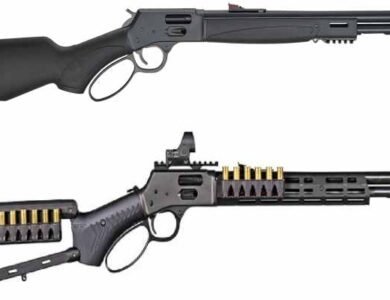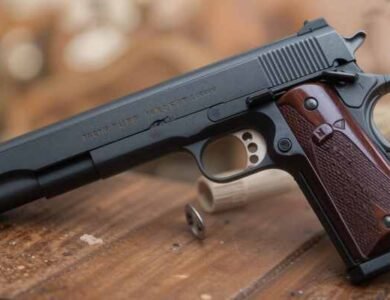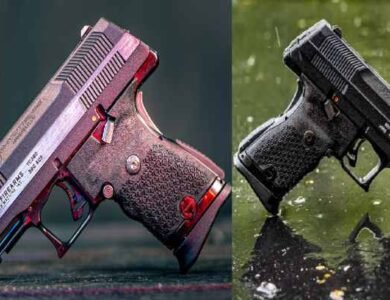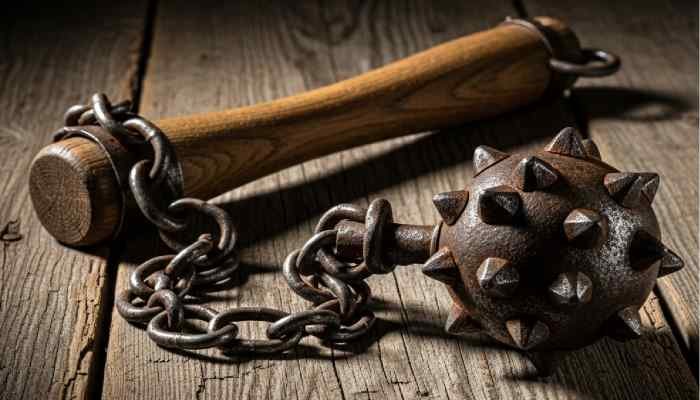
What Is a Mace Weapon?
A mace weapon is a type of blunt-force melee weapon designed to deliver powerful, crushing blows. Unlike swords or axes that rely on sharp edges, the mace uses a heavy head—typically made of metal—to break bones and damage armor. It became popular in ancient and medieval warfare for its simplicity and effectiveness against armored enemies. A mace consists of a sturdy handle (often wood or metal) and a head that may be smooth, flanged, or spiked.
The weapon evolved from primitive stone clubs to sophisticated iron weapons. Warriors, including knights and foot soldiers, favored the mace for close combat. Today, replicas of maces are used in reenactments and ceremonial events. Additionally, the term “mace” is sometimes confused with modern self-defense sprays, but they are unrelated. Overall, the mace remains a symbol of strength, authority, and historical warfare.
History of the Mace Weapon in Warfare
The mace weapon has existed for thousands of years. Its earliest versions date back to ancient Egypt and Mesopotamia, where stone maces were symbols of power and war tools. As metallurgy improved, civilizations began using bronze, then iron and steel to craft more deadly and durable maces. By the Middle Ages, the mace had become one of the most effective weapons against knights in full armor. Flanged and spiked designs helped penetrate plate armor and deliver disabling blows.
The weapon’s popularity spread across Europe, Asia, and the Middle East. In many cultures, maces also became ceremonial symbols of leadership. The Pope’s guards, royal guards, and even modern parliaments still use ceremonial maces. Over time, the weapon lost its battlefield role due to firearms, but its historical legacy continues in museums, historical reenactments, and fantasy fiction. The mace represents raw power and the evolution of early military strategy.
Medieval Mace Weapon: A Knight’s Best Friend
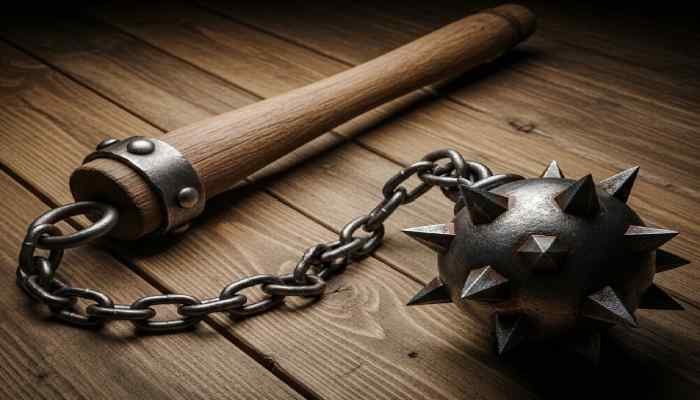
The medieval mace weapon was a staple of European knights during the Middle Ages. As plate armor became more common, swords lost some of their effectiveness. Maces filled that gap, delivering powerful, crushing strikes that could dent or even break armor. Unlike blades that required precision, maces inflicted damage through brute force. Knights often carried them as secondary weapons, especially during sieges or close-quarters combat.
Why Knights Used Maces:
-
Effective against armor
-
Easier to use than swords
-
Less likely to get stuck in enemy gear
Comparison Table: Sword vs. Mace
| Feature | Sword | Mace |
|---|---|---|
| Damage Type | Cutting | Blunt/Crushing |
| Armor Effectiveness | Moderate | High |
| Skill Required | High | Medium |
The mace’s ability to overcome heavy defense made it one of the most practical weapons in medieval combat.
Anatomy of a Mace: Parts and Construction
The construction of a mace weapon is simple but effective. It typically includes a sturdy shaft and a heavy head designed to deliver fatal blows. Over time, the design became more specialized, adapting to different combat needs and user preferences.
A traditional mace consists of three core parts:
-
Head – The striking part, often made of iron or steel. It can be flanged, spiked, or solid.
-
Shaft – Usually wooden or metal, offering grip and reach.
-
Pommel – A knob or counterweight at the end for balance.
Table: Common Materials Used in Mace Construction
| Part | Common Material |
|---|---|
| Head | Iron, steel, bronze |
| Shaft | Hardwood, iron, steel |
| Grip | Leather, cord, rough wood |
These components created a weapon that was both durable and deadly in close combat.
Also Read: Beretta A300 Ultima Patrol: Full Review & Buyer’s Guide
Spiked Mace Weapon: Design and Purpose
The spiked mace weapon was a deadly variation designed to enhance the destructive power of a standard mace. Instead of a smooth or flanged head, it featured sharp metal spikes protruding from the striking surface. These spikes could penetrate armor and cause deeper wounds, making it even more effective against well-armored opponents. Spiked maces were especially popular during the late medieval period when full plate armor became common.
Key Purposes of Spikes:
-
Add puncture damage to crushing blows
-
Tear flesh and armor
-
Intimidate enemies on the battlefield
Table: Flanged vs. Spiked Mace
| Feature | Flanged Mace | Spiked Mace |
|---|---|---|
| Damage Type | Blunt + Crush | Blunt + Puncture |
| Armor Effectiveness | High | Very High |
| Maintenance | Easier | More difficult |
Spiked maces were brutal, effective, and feared.
Flanged vs Spiked Mace Weapon: Key Differences
Both flanged and spiked mace weapons were designed to defeat armor, but their structure and damage types differed. A flanged mace has metal ridges or fins (flanges) that focus force into small areas, helping crack armor. A spiked mace, on the other hand, combines blunt trauma with piercing spikes, capable of puncturing even thick plate.
Key Differences:
| Feature | Flanged Mace | Spiked Mace |
|---|---|---|
| Head Design | Flat with metal ridges | Covered in pointed spikes |
| Primary Damage | Blunt force | Blunt + Piercing |
| Durability | More durable | Spikes may bend/break |
| Maintenance | Easier to clean | Requires more upkeep |
While flanged maces were easier to maintain, spiked maces caused more gruesome injuries. The choice often came down to personal preference or combat role.
Mace Weapon Chain: The Flail Explained
The mace weapon with a chain, commonly known as a flail, was a flexible weapon designed to bypass shields and strike from unexpected angles. Unlike fixed-head maces, a flail featured a spiked or flanged head attached to a chain, which was then connected to a wooden handle. This design allowed the weapon to generate more momentum and be swung over defenses.
Advantages of the Flail:
-
Could wrap around shields
-
Delivered unpredictable strikes
-
Harder to block due to its chain movement
Flail Types:
-
Single-head flail – One spiked ball on a chain
-
Double-head flail – Two spiked balls for increased damage
-
Agricultural flail – A converted tool used in peasant uprisings
Table: Mace vs. Flail
| Feature | Mace | Flail |
|---|---|---|
| Control | High | Low |
| Speed | Moderate | High |
| Skill Needed | Medium | High |
The flail was powerful but risky, requiring great skill to avoid self-injury.
Ceremonial and Symbolic Use of Maces
As warfare evolved, the mace weapon took on a new role: symbolism and ceremony. By the late Middle Ages and Renaissance, maces were no longer just weapons—they became symbols of authority, especially in royal courts, churches, and parliaments.
Maces used in ceremony were often highly decorated, with gold, silver, and intricate engravings. These items were not intended for combat but served as emblems of power and governance.
Common Ceremonial Uses:
-
Royal processions
-
University graduations
-
Parliamentary sessions
-
Religious ceremonies
For example, the Serjeant-at-Arms in the UK Parliament carries a ceremonial mace, signifying the monarch’s authority in the House of Commons.
Unlike battle-ready maces, ceremonial ones are typically larger and more ornate. Despite their peaceful role, their roots remind us of a violent past, where they once cracked armor instead of leading ceremonies.
Combat Techniques with a Mace Weapon
Using a mace weapon in combat required strength and skill, but less finesse than swords or daggers. The mace’s main advantage was its ability to deliver powerful, crushing blows that could incapacitate armored foes.
Common Combat Techniques:
-
Overhead Strikes: Delivering forceful downward blows to break helmets or shields.
-
Sweeping Attacks: Swinging horizontally to hit multiple enemies.
-
Pommel Strikes: Using the handle end for close combat.
-
Hooking Moves: Catching an opponent’s weapon or shield with flanges or spikes.
Benefits of the Mace in Battle:
-
Effective at breaking bone and denting armor.
-
Requires less precision than cutting weapons.
-
Can be used in close quarters where swords might be less effective.
Despite its weight, skilled warriors could strike with surprising speed and control. The mace was a weapon designed to deliver stopping power in brutal, messy fights.
Famous Historical Examples of Mace Use
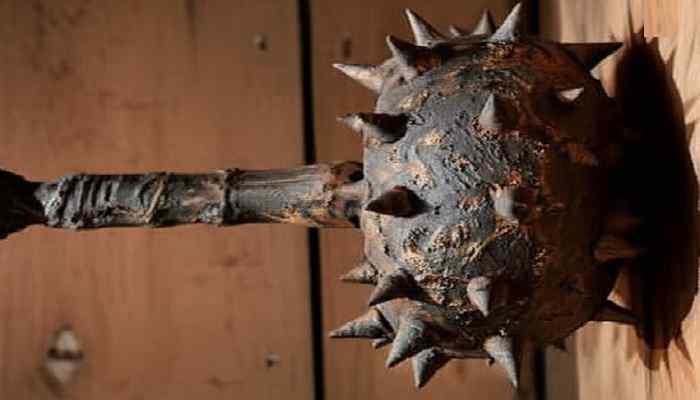
Throughout history, the mace weapon was wielded by notable warriors and armies around the world. It was a preferred weapon when armor rendered swords ineffective.
Historical Examples:
-
Charles Martel (8th century): Known for using a heavy mace at the Battle of Tours.
-
Joan of Arc’s era knights often carried maces as backup weapons.
-
Russian Cossacks used flails, a chain-linked mace, in their cavalry.
-
The Crusaders heavily favored maces against Muslim warriors’ chainmail.
Regional Use:
-
Europe favored spiked and flanged maces.
-
The Middle East and Asia had lighter versions with decorative elements.
-
Eastern Europe incorporated ornate ceremonial maces for nobility.
These examples highlight the mace’s versatility—from brutal battlefield tool to a symbol of nobility and power.
The Mace Weapon in Pop Culture and Games
The mace weapon has a strong presence in popular culture, especially in fantasy books, video games, and movies. It symbolizes raw power and medieval combat.
Popular Appearances:
-
Games: Titles like Skyrim, World of Warcraft, and Dark Souls feature various types of maces as melee weapons.
-
Movies: Films like The Lord of the Rings and Game of Thrones show characters wielding maces in epic battles.
-
Books: Fantasy novels often depict warriors or clerics using maces as their weapon of choice.
Why the Mace Is Popular:
-
Represents brute force and strength.
-
Visually distinctive with spiked or flanged heads.
-
Appeals to players who prefer close combat, heavy-hitting weapons.
This cultural presence keeps the mace relevant, even centuries after it left the battlefield.
Can You Legally Own a Mace Weapon Today?
The legality of owning a mace weapon depends heavily on your country or state laws. Many places treat antique or replica maces as collectible weapons, while others have strict restrictions.
Legal Considerations:
-
Antique maces: Often legal as collectibles or display pieces.
-
Replica weapons: May require permits or have usage restrictions.
-
Self-defense sprays called “mace”: Legality varies and is separate from the weapon.
Tips for Potential Owners:
-
Check local weapon laws before purchasing or carrying.
-
Avoid carrying maces in public without permission.
-
Use maces primarily for historical reenactment or display.
In many places, maces are seen more as historical artifacts than practical weapons, but it’s important to follow local regulations to avoid legal issues.
Modern Mace vs Ancient Mace: Big Differences
The term “mace” today often refers to two very different things: the ancient blunt weapon and the modern self-defense spray. Understanding their differences is important.
Ancient Mace:
-
Heavy, made of metal and wood
-
Used in melee combat to crush armor and bones
-
Symbol of medieval warfare and authority
Modern Mace (Pepper Spray):
-
Small, handheld aerosol device
-
Contains irritants like oleoresin capsicum (OC)
-
Used for self-defense, causes temporary blindness and pain
| Feature | Ancient Mace | Modern Mace (Spray) |
|---|---|---|
| Purpose | Close combat weapon | Personal defense |
| Size | Large, handheld | Compact, pocket-sized |
| Usage | Physical strikes | Chemical deterrent |
| Legal Status | Varies by country | Often regulated as a controlled item |
Though they share a name, the two “maces” serve completely different roles—one historical and one modern.
How to Buy a Replica Mace Weapon
If you’re interested in owning a replica mace weapon for collection, reenactment, or display, there are important things to consider.
Tips for Buying:
-
Choose reputable sellers: Specialty weapon or historical replica stores.
-
Check materials: Steel heads and hardwood shafts are more durable.
-
Look for craftsmanship: Detailed engraving and balanced weight improve authenticity.
-
Verify legality: Confirm your local laws about owning replica weapons.
- Click here to: know more about all types of weapons.
Common Places to Buy:
-
Online stores like Museum Replicas and Arms & Armor
-
Historical reenactment fairs and weapon shows
-
Specialty medieval shops
Table: Replica Mace Price Range
| Type | Price Range (USD) |
|---|---|
| Basic metal/wood | $50 – $150 |
| High-quality replicas | $200 – $600 |
| Ornate ceremonial replicas | $700 and up |
Buying a good-quality replica enhances your collection and ensures safe handling.
Mace Weapon Maintenance and Display Tips
Proper maintenance and display keep your mace weapon in good condition, whether it’s a real antique or a replica.
Also Read: Canik TTI Combat: Full Review, Specs, Price & More
Maintenance Tips:
-
Clean metal parts regularly to prevent rust.
-
Use oil or wax on wooden shafts to avoid drying and cracking.
-
Inspect joints and fittings for wear.
-
Store in a dry place away from humidity.
Display Tips:
-
Use a sturdy wall mount or display stand.
-
Keep away from direct sunlight to preserve materials.
-
Consider a glass case for valuable antiques.
-
Label with historical information to educate viewers.
Regular upkeep ensures your mace remains a striking piece of history and art.
FAQs About Mace Weapon
-
What is a mace weapon?
A mace is a blunt weapon with a heavy head used to crush armor and bones. -
What is a spiked mace?
A mace with sharp spikes on its head designed to pierce armor and cause deeper wounds. -
How was the mace used in medieval warfare?
It was swung to deliver powerful crushing blows, effective against armored knights. -
What is the difference between a mace and a flail?
A mace has a fixed head, while a flail has a spiked head attached to a chain. -
Are mace weapons legal to own today?
Legality varies by location; many places allow owning replicas but restrict carrying. -
What materials are maces made from?
Typically iron or steel heads with wooden or metal shafts. -
Why did knights carry maces instead of just swords?
Maces were better at damaging armor and required less precision than swords. -
What is a ceremonial mace?
A decorative mace symbolizing authority, used in parliaments and royal ceremonies. -
How do you maintain a mace weapon?
Regularly clean metal parts, oil wooden shafts, and store in dry conditions. -
Is modern “Mace” spray related to the mace weapon?
No, modern Mace is a pepper spray used for self-defense, unrelated to the weapon.
Conclusion: The Legacy of the Mace Weapon
The mace weapon is more than just a medieval tool of war—it is a symbol of strength, resilience, and authority throughout history. From ancient battlefields to royal ceremonies, the mace has evolved, serving practical and symbolic roles. Its design, whether spiked, flanged, or chained, reflected the needs of its time and the evolution of armor and warfare. Today, it fascinates historians, collectors, and fans of pop culture alike. Whether as a deadly weapon, ceremonial icon, or fantasy staple, the mace’s legacy endures. Understanding its history and variations enriches our appreciation of past combat and the cultural importance attached to this mighty weapon.

